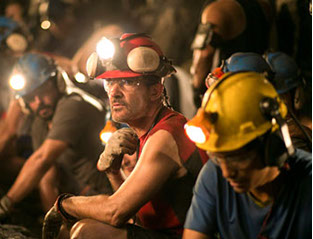
Down Under
In 2010, when 33 Chilean miners were trapped for 69 days in a collapsed mine and the entire world waited for their rescue in earnest anticipation, some of the more cynical observers in the viewing audience could hardly be blamed for wondering which big time Latino actors would be eventually cast to play the men at the center of the real life drama.
The producers of the film “The 33,” based on Hector Tobar’s masterful account of the entire ordeal, have seen fit to cast a generation-spanning swath of Latino stars in an uplifting film about being 700 meters below the surface of the earth.
to cast a generation-spanning swath of Latino stars in an uplifting film about being 700 meters below the surface of the earth.
Antonio Banderas plays Mario Sepulveda, a man who so excels at inspiring confidence in his fellow miners that they call him “Super Mario.” Lou Diamond Phillips is Don Lucho, an uncertain shift supervisor who does not think it is particularly wise to keep hope alive.
The rest of the cast completes a microcosm of maleness. Rodrigo Santoro (the Brazilian actor who appeared as a heartthrob in “Love Actually” and a god of war in “300”) plays Laurence Golborne, an inexperienced Chilean minister of mining who is charged with overseeing the rescue efforts. Colombian actor Juan Pablo Raba plays a troubled young alcoholic who, cut off from his booze, must sweat through the DTs before finding redemption and a new reason to live. Oscar Nunez (of the “The Office”) plays an amorous jokester, and Gustavo Angarita plays a miner who was just about to be retired before he suddenly got so woefully mired.
Tracking the plight of exploited men who have found themselves in a very dark place, “The 33” is believable mostly because we all know that it really happened.
Mexican director Patricia Riggen relies upon the fact that viewers will already be familiar with the heroics on screen. The general foreknowledge of events depicted allows her to eschew the dull exposition of story set-up and rather flood her film with the arresting visuals of an arid landscape and an undaunted atmosphere of conviviality that can exist even amid almost certain doom.
With its stylish camera work and its representation of a rare yet tenable tenacity, “The 33” seems like a sped-up Michelangelo Antonino film with a script courtesy of the Hallmark channel. It is a commercial for the human spirit wherein the product being sold is the good news that people all over really do want to help each other out. Global media coverage, of course, allows for all this global concern to happen. When the miners were trapped for over three months it was obvious that everyone wanted to lend a hand. Seriously, can anyone think of another situation wherein Oakley Sunglasses would have given out free eyewear to Latino laborers?
In this respect, this film about miners ironically entombed in a pit of precious metals, misses out on a few golden opportunities. It should have been filmed in Spanish. The fact that these guys are all speaking in a heavily accented English is a kink in the verisimilitude that could have otherwise gone smooth.
All of this if forgivable because we want to see these guys get out alive, and we know that they will. In the course of their cinematic survival, which harkens back to the kind of male-bonding ingenuity seen in the 1965 Jimmy Stewart disaster movie “Flight of the Phoenix,” we see the miners ration out food and quell an impulse towards self-destruction. Incorporating international TV news footage alongside the dim reality of the cramped quarters adds to the sense of economic disparity amid the unity of brotherly love.
A moviegoer, jaded or not, will watch “The 33” and concede that the mine collapse was terrible and perhaps unnecessary but that the rescue effort was a thing of beauty.
The less grandiose story to come out of the collapse is linked to all the legal action that ensued once these guys were back on the surface. Just in time for the release of “The 33,” nine of Chilean miners sued their lawyers claiming that they had been cheated out of funds related to films, TV shows, and books based on their unbelievable story of survival.
Roberto Ontiveros